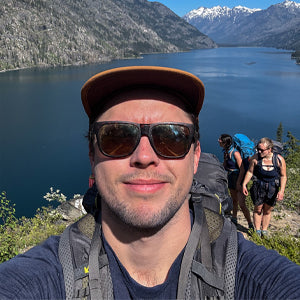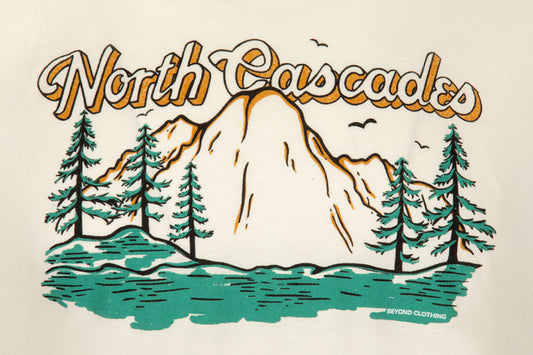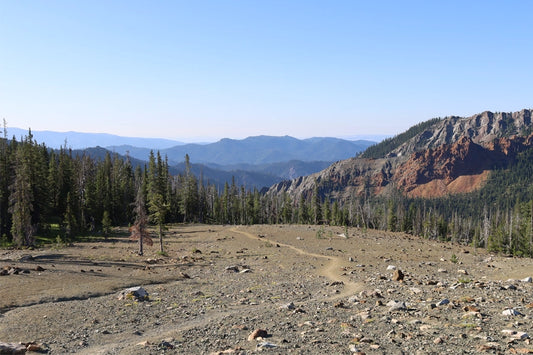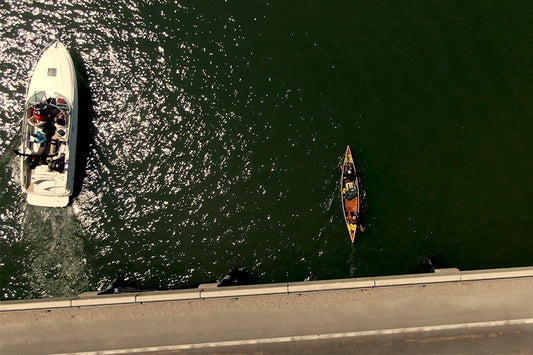
(Wearing the Men's Geo-T Hoodie and Tarngood Pant)
Jump to:
Like the flip of a switch, July 5th marks the true start of summer in the Pacific Northwest. Almost ceremoniously, the holiday signals the parting of rain clouds, the melting of snowpack and the definitive end to shoulder season. At last, it feels like summer—Seattleites can finally shed their puffy jackets and take a stand against vitamin D deficiency. Summer has landed.
Having paid my dues during the gray months, I’m cashing in my ~16 hours of daylight on the trails this summer. Primarily a runner, hiker and backpacker, my choice mountain activities range anywhere from a couple hours to multi-day off-grid excursions, with each adventure calling for a unique set of skills, gear and preparation.
To stay prepared for my summer adventures, I’ve curated three checklists that cover all my outdoor essentials, based on each outing's requirements and overall level of difficulty. Typically, my outings fall within one of three buckets: day hiking, trail running and multi-day backpacking. Here’s a breakdown of the gear I bring along for each ride.
But first, a few disclaimers on my approach to this guide:
- The Ten Essentials of hiking are recommended for every hike, regardless of difficulty or scale. When in doubt, use this list to prepare for an outdoor adventure.
- While it’s always best to be prepared, many scenarios do not call for all ten essentials. If I’m hiking a short, routine trail within cell service (let’s say one my favorite hikes, Poo Poo Point), it’s unlikely I’ll pack an emergency blanket and paper map!
- This being said, the purpose of this guide is to break down my personal regimen when planning for various outdoor adventures. Take what you like from this guide, disregard what you don’t, know your limits and use your best judgment.

(Rocking the Firstsun Shirt and Tarngood Pant)
DAY HIKING CHECKLIST
When planning for any outdoor adventure, there are several key factors to consider. Weather, mileage and elevation gain are some of the more obvious indicators of difficulty. Taking a step further, there are less obvious factors that impact the gear you’ll need on a hike. Is there cell service? How many miles are you from the nearest road/trailhead? Are there water sources? What kind of wildlife should I expect? The list goes on indefinitely—for the sake of this guide, we’ll assume a day hike is on the less extreme side of the adventure spectrum, since we’ll cover off more extreme adventures—like the Enchantments—further below.
For now, let’s assume a day hike means less than 10 miles in summer conditions, so no snow. Generally speaking, this won’t take you too far from the nearest paved road (in other words, it’s not as difficult for help to find you) and should take roughly half a day to complete. Assuming these parameters, here’s what I’m packing, along with some notes from my personal experiences:
WEARABLES
-
Apparel - Breathability is a top priority for warm weather hiking. My favorite hiking shirt this season has been the new FirstSun Short Sleeve (pictured above). It has a UPF 50+ rating, feels great on the skin and I control the level of breathability with the hidden-snap buttons. The built-in, microfiber sunglasses cleaning cloth is a nice touch and in a pinch, it doubles as a camera lens wipe, too.
As far as bottoms, the TarnGood Shorts will tackle any hike. Made mobile with a nylon/spandex fabric blend and gusseted crotch, these shorts have laser-cut ventilation holes along the inseam, promoting breathability with every movement. Plus, they have that UPF 50+ sun protection rating, similar to the First Sun Short Sleeve. They’re stretchy, durable and quick drying—everything I’m looking for in adventure shorts.
-
Hiking Shoes - Zero-drop, lightweight trail runners are my footwear of choice for hiking, running and backpacking. I’ll go to bat on this one.
-
Watch - A great tool for tracking mileage, heart rates and a plethora of other data. I’m team Garmin because of the exceptional battery life and the multitude of useful navigation, fitness and health tracking features.
-
Hat - I love the Beyond Outfitters Tech Hat. It’s water repellent, so it won’t get ruined by sweat. I toss mine in the wash when needed and it holds its shape without issue.
-
Sunglasses - Bring a pair that you’re okay with dropping and scratching.
- Packable Rain Jacket - A self-stowing, packable rain jacket that you can cram into the bottom of your pack and forget about is always a good idea. The Yuba Anorak is my go-to.
GEAR
-
Daypack - For the average day hike, 18-25 liters is more than enough capacity.
- Navigation - I download my routes from AllTrails on to my phone before every hike. Not only is this a great safety play, it’ll show you how many miles you have left, elevation you have to climb/descend and other key data you’ll need to make informed decisions in the backcountry.
WATER AND NUTRITION
-
Food and Water - Bring more than you think you’ll need. It’s better to have and not need than to need and not have, especially as temperatures rise. My go-to snacks include fruit, granola bars and PB&J sandwiches.
- Water Filter - Not always necessary, but it’s so easy to toss a BeFree in your pack. It hardly takes any space and nothing tastes better than cold mountain water.
OTHER NECESSITIES
-
Sunscreen - A necessary layer of defense when exposed to direct sunlight.
-
First Aid - Another easy item to keep in your pack at all times, even if you don’t use it.
- Optional - Camera, trekking poles, bathroom kit/toilet paper.
TRAIL RUNNING CHECKLIST
I’m currently training for my first ultramarathon, a 50-mile trail run in Oregon this September. As part of my training, each weekend consists of at least one long run, typically between 18 and 26 miles. I take these long runs more seriously than a casual day hike—there’s more ground covered, more calories burned and an increased chance of injury. As such, these excursions require more planning, more gear and more time. The tradeoff? They’re more fun. Here are my must-haves:

WEARABLES
-
Apparel - The Hooded Geo-T is exceptionally breathable with UPF 50+ protection. When it’s scorching, staying protected from the sun is paramount. The ability to essentially create my own shade with the Geo-T has saved me from overheating on more than one occasion, as you can see in the picture above on my trek to Granite Mountain.
Outside of heat waves and extreme exposure, the FirstSun Short Sleeve is another preferred choice. Adjustable breathability is a game changer and the collar prevents my neck from chafing against my vest. Look good, feel good.
Lastly, the SolarSwift Short Sleeve Tech-T is yet another trail running go-to. It’s simply well-built and designed to hold up against snags and abrasions on the trail with a great fit and comfortable, breathable fabric.
Beyond Clothing’s new Summer Collection knocked it out of the park. Breathable, comfortable and stylish, each of these three pieces are heavy in my current rotation.
-
Trail Shoes - Boots won’t get it done here. I need a lightweight runner with aggressive traction built for rugged terrain.
- Previously Listed - I’ve already discussed these items in the prior section, but they belong on my trail running checklist, too. I’ll continue to use this format throughout the rest of this post to reduce redundancies.
- Watch
- Hat
- Sunglasses
- Packable Rain Jacket
GEAR
-
Running Vest - This glorified backpack comes with strategic pocket placement and a snug next-to-body fit. It's key to staying light and fast while still hauling the gear I need for a 20+ mile day.
- Satellite Communicator - I always bring a satellite communicator, especially when running solo. This is one of those odd gadgets that is expensive and one that I hope I’ll never need, but in the event of an emergency, I like knowing I can call in reinforcements. The ability to communicate with and update loved ones goes a long way, too.
-
Navigation - Again, trail running typically involves further distances across less-traveled terrain, so you’ll want to know where you’re going. It’s increasingly important to download your maps as adventures grow in distance and time.
- Air Horn/Bear Spray - Since you’re covering more ground than the typical day-hiker, trail running often involves delving deeper into the backcountry than the majority of day hikers. I like to keep an air horn on my person, always within reach, to scare off any hungry predators that might be found in these less-crowded sections of trail. Bear spray works too, but is a little bulky to run with.
WATER AND NUTRITION
-
Water Reservoir - Using my reservoir, I can drink water through a tube, allowing me to hydrate without stopping. This is far more convenient than using a traditional water bottle when running.
-
Water Filter - An absolute essential for summer long runs. I can often get away with leaving this behind on a day hike, but I always bring a filter on my long runs.
- Fuel/Electrolytes - I typically bring a mix of gels, Honey Stingers, energy blocks and a PB&J. When sweating for 5+ hours, bringing extra electrolytes and sodium go a long way. Under fueling is the easiest way to have a bad day.
OTHER NECESSITIES
- Anti-Chafe Stick - No further explanation needed.
-
Bathroom Kit/Toilet Paper - I typically bring toilet paper, wet wipes, a trowel and hand sanitizer. This has been upgraded from optional to mandatory. Don’t learn this one the hard way.
-
Plastic Sandwich Bag - A surefire waterproofing method for important electronics, like my phone.
- Previously Listed
- Sunscreen
- First Aid
- Optional - Trekking poles, headlamp and headphones. I usually ditch the headphones, but tossing a single ear bud in can distract the mind when you need it.

BACKPACKING CHECKLIST
Lastly, let’s go through my gear list for a multi-day, off-grid backpacking adventure. These are my most extreme outdoor adventures—it’s expected that I’ll be off-grid for days at a time, miles away from cell service, running water and a proper hot meal. Of my three categories of outdoor adventures, these require the most planning, the most gear and often result in the most rewarding experiences.
WEARABLES
-
Apparel - Spending entire days in the outdoors—from the moment you wake up until you go to sleep—requires apparel that can withstand rugged environments while keeping you cool and protected all day long. The TarnGood Pant is perfect for extended hours in the elements—similar to its shorts-version counterpart, it comes with a UPF 50+ rating and laser-cut ventilation holes. I’m glad they’ve opted for the adjustable drawstring waistband, which has come in handy on summer hikes when I leave my belt behind. With the gusseted crotch, it’s mobile and adventure-ready. Bonus points for coming in earth tones that contribute to keeping you cool all day.
The mountains can get cold at night, easily dipping below freezing even during peak summer. Pack insulation layers to stay warm—the Alpha Aura is exceptionally lightweight for how warm it is.
- Camp Shoe - A step-in, comfortable camp shoe can’t be understated (especially for midnight bathroom breaks). While certainly not ultralight, my Birkenstocks always come along for the journey.
- Previously Listed
- Hiking Shoes
- Watch
- Hat
- Sunglasses
- Packable Rain Jacket
GEAR
- Backpacking Pack - My 55L gets the job done for 1-3 night trips.
-
Trekking Poles - When carrying heavy packs through water crossings and other technical terrain, poles are incredibly helpful in dispersing weight and saving your legs. Your knees will thank you. For backpacking, poles are a must-have!
- Backpacking Tent - Don’t stress the ounces here, but you’ll want a tent specifically designed for backpacking. Traditional ground tents are too bulky and too heavy to lug around for miles at a time.
-
Sleep System - My system includes a 15*F sleeping bag, foam sleeping pad and inflatable pillow. I could upgrade my system with an inflatable sleeping pad, but it’s not totally necessary for summer trips. A foam pad will never pop and fail you.
-
Cooking System - My system includes a stove, pot, titanium spork and isobutane fuel. Pro tip: find a utensil with a long handle. When eating out of the bag of a dehydrated backpacking meal, shorter utensils easily fall completely into the bag and become more of a chore to clean.
-
Camp Mug - How else would you use to drink your coffee? The classic enamel mug is tried-and-true.
-
Bear Canister - Expensive but a necessary investment. The rule of thumb is to store food at least 100ft from camp. Keep all food, toothpastes and other scented items that a bear might confuse for a snack in here, far from camp at night.
-
Headlamp - Spend the extra buck and go for a headlamp with a red light option. Your hiking buddies will thank you for not blinding them at night.
- Multi-Tool - Needed for repairs, first aid and general outdoor use.
- Dry Bags - Great for protecting electronics or separating dirty laundry from super dirty laundry.
-
Power Bank + Cables - I bring a power bank to keep my phone, watch, camera, GPS device and other essential electronics operating when off-grid. The Bunker 3-in-1 Cable is a durable, fast-charging multi-cable that covers USB-C, USB-A and Lighting compatible devices, streamlining the packing process and keeping me connected when exploring.
- Previously Listed
- Satellite Communicator
- Navigation
- Air Horn/Bear Spray
WATER AND NUTRITION
-
Food - There are a multitude of options when planning your backcountry meals. Some folks dry meat and create their own mixes of various, non-perishable snacks. Pre-made, dehydrated meals that you can buy at your local outdoor store are some of the easiest and most popular options. They can be bulky, but if you pack strategically, they will get the job done and keep you fueled. And some are pretty dang tasty.
Another pro tip: bring tortillas. They fit seamlessly at the bottom of a bear canister and you’ll appreciate the extra calories. Backpacking food always tastes better out of a tortilla.
- Coffee - I use instant coffee. While it’s not the most luxurious option, it cuts back on space and weight and tastes… good enough. You have to lower your standards a bit when backpacking.
- Previously Listed
- Water Reservoir
- Water Filter
OTHER NECESSITIES
- Small Towel - A small towel to dry yourself off, wipe your hands and clean dirty items is a handy backcountry tool.
- Trash Bags - I bring the larger Ziplock freezer bags. Your snack bars, dehydrated meals and other wrappers will quickly add up and you’ll want to keep these separate from your other kit. Littering is for losers.
-
Oral Hygiene Products - Toothbrush and toothpaste. The foldable travel toothbrushes you can find at the gas station work great.
-
Lighter/Matches - This is survival 101. Pack these.
- Gear Repair Kit - When you need to patch a hole, repair your stove or salvage a sleeping pad, a gear repair kit will come in handy.
-
Optional - Camera, book, playing cards. Backpacking can involve lots of down time. Savor your time away from the never-ending onslaught of notifications and read a book or play cards with your friends!
- Previously Listed
- Sunscreen
- First Aid












0 Comments